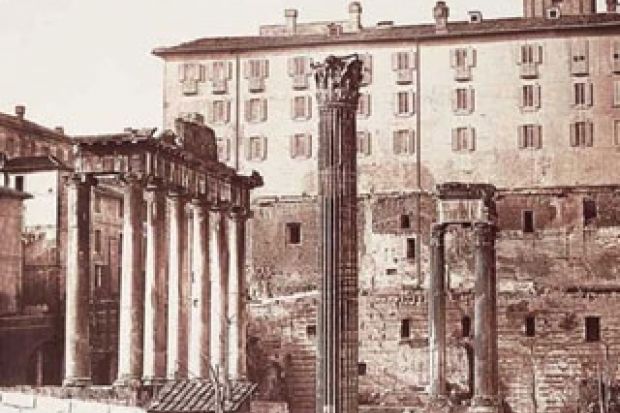Yale University Press is to be congratulated on producing, at not too high a price, another elegant volume, furnished with many beautiful illustrations as well as with notes and bibliography that occupy more than 100 pages as against a text of just over 200. Roman Fever will shine on a coffee table. The book is a pleasure to riffle.
No doubt that is as it should be, since Richard Wrigley assures his readers disarmingly on more than one occasion that he is an art historian who writes with the assumptions and theoretical base of his trade. “From the sixteenth until the late nineteenth century,” he pronounces, “Rome held a talismanic place in the European and later North American imagination as a destination of artistic pilgrimages.” Given that situation, he sets his task as to enquire “what did influence [then] mean…as applied to artists’ and travellers’ experience of Rome?” “Influence”, he knows from Michel Foucault, is an under-theorised term, all the more since, he adds, it has ironical connections with the Italian “influenza”, a word that began to acquire an international medical meaning following an epidemic of some sort in Rome in 1743.
As the title indicates, Wrigley’s major focus is on mal’ aria, the “something in the air”, as he evocatively puts it, that was the physical background to what he establishes was often a fundamental uneasiness, even a trauma, afflicting artists and travellers as they tried to frame a meaning of classical and Renaissance, and, less often, contemporary, Rome around their own creativity. For the Abbé Dubos in 1719, we learn, what had once been a fine climate in the city had been destroyed during its decline and fall. Such environmental change could explain why “decadent” contemporary Romans had lost in the battle between ancients and moderns then being waged so vigorously, but might also allow non-Italian moderns their own victory. As Wrigley hastens to remark, not everyone agreed; for some, Roman “light” was eternally “special”; its air enthralled still. Yet, Wrigley shows in his key chapters, the fatal presence of malaria could not be ignored, especially given the rise into the 19th century of medical understandings of the human condition.
Wrigley’s major focus is on mal’ aria, the ‘something in the air’
Quite often such comprehension did not go far. Wrigley is at his drollest when he indicates efforts by experts to map just which part of the city was vulnerable to the disease and which was not. He cites one English traveller’s perplexing advice in 1813 that “At St. Callixtus, the cells next to the country are unhealthy in summer, while the opposite side of the convent is safe”. Opinion, we learn, was more united in dreading the Campagna surrounding Rome, although even it could be viewed by Thomas Ashby, early paladin of the British School in Rome, as an enticing expanse of classical treasure. Wrigley in his lengthiest chapter reproduces many lovely images of this treacherous but redolent countryside.
There is much of interest and importance in this commentary. Yet, for your reviewer, who is a historian and not an art historian, Wrigley’s findings are fretted by a curiously imprecise chronology and a failure to take his contextual imagining far. The Enlightenment, the Italian and Roman confrontation with the French Revolution and especially its hostility to peasant “backwardness”, the Industrial Revolution (which surely changed the meaning of “dirt” for many Europeans and so must have conditioned the earlier view, examined in detail in chapter 6, that Rome was “one of the dirtiest cities in Europe”), the rise of the modern nation (“Italy” seems always to be Italy for Wrigley), the spread of modern imperialism and its linked racial “science” (and of Italy’s unbecoming role as the least of the Great Powers) – none of these crucial developments rates a major place in Wrigley’s account. Even the Roman Catholic Church, its changes and continuities, its myths and images, remain noises off. The result is that Wrigley’s book contains some fascinating description of artists’ thoughts about the medical perils of Rome and its hinterland. But he scarcely achieves his (laboured) initial promise of a full-scale rethinking of “influence”, “acting through an ambient, immersive dimension as much as being the result of conscious ambition be that individual or institutional”.
